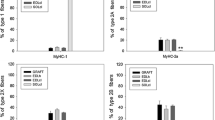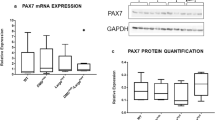Abstract
Plasticity of mature muscles exposed to different activation patterns is limited, probably due to restricted adaptive range of their muscle fibres. In this study, we tested whether satellite cells derived from slow muscles can give rise to a normal fast muscle, if transplanted to the fast muscle bed. Marcaine-treated rat soleus and extensor digitorum longus (EDL) muscles were transplanted to the EDL muscle bed and innervated by the ‘EDL’ nerve. Six months later expression of myosin heavy chain isoforms was analysed by areal densities of fibres, binding specific monoclonal antibodies, and by SDS gel electrophoresis. Both regenerated muscles closely resembled each other. Their myosin heavy chain profiles were similar to those in fast muscles although they were not identical to that in the control EDL muscle. Since not even regenerated EDL was able to reach the myosin heavy chain isoform profile of mature EDL muscle, our experimental model did not permit studying the adaptive capacity of satellite cells in different muscles in its whole extent. However, the results favour the multipotential myoblast stem cell population in rat muscles and underline the importance of the extrinsic regulation of muscle phenotype.
Similar content being viewed by others
References cited
Ausoni S, Gorza L, Schiaffino S, Gundersen K, Lømo T (1990) Expression of myosin heavy chain isoforms in stimulated fast and slow rat muscles. J Neurosci 10, 153-160.
Bigard XA, Janmot C, Merino D, Leinhard F, Guezennec YC, d'albis A (1996) Endurance training affects myosin heavy chain phenotype in regenerating fast-twitch muscle. J Appl Physiol 81, 2658-2665.
Bigard XA, Serrurier B, Merino D, Lienhard F, Berthelot M, Guezennec YC (1997) Myosin heavy chain composition of regenerated soleus muscles during hindlimb suspension. Acta Physiol Scand 161, 23-30.
Botinnelli R, Schiaffino S, Reggiani C (1991) Force-velocity relations and myosin heavy chain isoform compositions of skinned fibres from rat skeletal muscle. J Physiol 437, 655-672.
Caiozzo VJ, Baker MJ, Mc Cue SA, Baldwin KM (1997) Single fiber and whole muscle analyses of MHC isoform plasticity: interaction between T3 and unloading. Am J Physiol 273, C944-952.
Carlson BM, Gutman E (1976) Free grafting of the extensor digitorum longus muscle in the rat after Marcaine pretreatment. Exp Neurol 53, 82-93.
Carlson BM (1986) Regeneration of entire skeletal muscles. FASEB J 45, 1456-1460.
d'Albis A, Pantaloni C, Bechet J-J (1979) An electrophoretic study of native myosin isoenzymes and their subunit content. Eur J Biochem 99, 261-272.
d'Albis A, Couteaux R, Janmot C, Mira J-C (1989) Myosin isoform transition in regeneration of fast and slow muscles during postnatal development of the rat. Dev Biol 135, 320-325.
De Nardi C, Ausoni S, Moretti P, Gorza L, Velleca M, Buckingham M, Schiaffino S (1993) Type 2X myosin heavy chain is coded by a muscle fiber type-specific and developmentally regulated gene. J Cell Biol 123, 823-835.
Devon ST, White TP (1996) Myosin heavy chain of immature soleus muscle grafts adapts to hyperthyroidism more than to physical activity. J Appl Physiol 80, 789-794.
Di Mario JX, Fernyak SE, Stockdale FE (1993) Myoblasts transferred to the limbs of embryos are committed to specific fibre fates. Nature 362, 165-167.
Diffee GM, Caiozzo VJ (1991) Contractile and biochemical properties of rat soleus and olantaris after hindlimb suspension. Am J Physiol 260, C528-C534.
Dolenc I, Črne-Finderle N, Eržen I, Sketelj J (1994) Satellite cells in slow and fast rat muscles differ in respect to acetylcholinesterase regulation mechanisms they convey to their descendant myofibers during regeneration. J Neurosci Res 37, 236-246.
Draeger A, Weeds AG, Fitzsimons RB (1987) Primary, secondary and tertiary myotubes in developing skeletal muscle: a new approach to the analysis of human myogenesis. J Neurol Sci 81, 19-43.
Dubois JD, Dussault JH (1977) Ontogenesis of thyroid function in the neonatal rat. Thyroxine (T4) and triiodothyronine (T3) production rates. Endocrinology 101, 435-441.
Düsterhöft S, Pette D (1993) Sattelite cells from slow rat muscle express slow myosin under appropriate culture conditions. Differentiation 53, 25-33.
Edom F, Mouly V, Barbet JP, Fiszman MY, Butler-Brown GS (1994) Clones of human satellite cells can express in vitro both fast and slow myosin heavy chains. Dev Biol 164, 219-229.
Fauteck SP, Kandarian SC (1995) Sensitive detection of myosin heavy chain composition in skeletal muscle under different loading conditions. Am J Physiol 268, C419-C424.
Feldman JL, Stockdale FE (1991) Skeletal muscle sattelite cell diversity: sattelite cells form fibres of different type in culture. Dev Biol 141, 24-40.
Haddad F, Arnold C, Zeng M, Baldwin K (1997) Interaction of thyroid state and denervation on skeletal myosin heavy chain expression. Muscle Nerve 20, 1487-1496.
Hämäläinen N, Pette D (1996) Slow-to-fast transition in myosin expression of rat soleus muscle by phasic high-frequency stimulation. FEBS Lett 399, 220-222.
Hoh JFY, Hughes S (1988) Myogenic and neurogenic regulation of myosin gene expression in cat jaw-closing muscles regenerating in fast and slow limb muscle beds. J Muscle Res Cell Motil 9, 59-72.
Hughes SM, Blau HM (1992) Muscle fibre pattern is independent of cell lineage in postnatal rodent development. Cell 68, 659-671.
Izumo S, Nadal-Ginard B, Mahdavi V (1986) All members of the multigene family respond to thyroid hormone in a highly tissue-specific manner. Science 231, 597-542.
Jakubiec-puka A, Kordowska J, Catani C, Carraro U (1990) Myosin heavy chain isoform composition in striated muscle after denervation and self-reinnervation. Eur J Biochem 193, 623-628.
Järva J, Alev K, Seene T (1997) The effect of autografting on the myosin composition in skeletal muscle fibers. Muscle Nerve 20, 718-727.
Kirschbaum BJ, Kucher H-B, Termin A, Kelly AM, Pette D (1990) Antagonistic effects of chronic low frequency stimulation and thyroid hormone on myosin expression in rat fast-twitch muscle. J Biol Chem 265, 13974-13980.
Larsson L, Edström L, Lindegren B, Gorza L, Schiaffino S (1991) MHCcomposition and enzyme-histochemical and physiological properties of a novel fast-twitch motor unit type. Am J Physiol 261 (Cell Physiol 30), C93-101.
Mauro AJ (1961) Sattelite cells of skeletal muscle fibres. J Biophys Biochem Cytol 9, 493-495.
Midrio M, Danieli-Betto D, Megighian A, Velussi C, Catani C, Carraro U (1992) Slow-to-fast transformation of denervated soleus muscle of the rat, in the presence of an antifibrillatory drug. Pflügers Arch Eur J Physiol 420, 446-450.
Miller JB (1990) Myogenic programs of mouse muscle cell lines: expression of myosin heavy chain isoforms, MyoD1, and myogenin. J Cell Biol 111, 1149-1159.
Mouly V, Edom F, Barbet JP, Butler-Brown GS (1993) Plasticity of human satellite cells. Neuromusc Disord 3, 371-377.
Narusawa M, Fitzsimons RB, Izumo S, Nadal-Ginard B, Rubinstein NA, Kelly AM (1987) Slowmyosin in developing rat skeletal muscle. J Cell Biol 104, 447-459.
Pette D, Staron RS (1990) Cellular and molecular diversities of mammalian skeletal muscle fibers. Rev Physiol Biochem Pharmacol 116, 1-76.
Pette D, Staron RS (1997) Mammalian skeletal muscle fiber type transitions. Int Rev Cytol 170, 143-223.
Pette D, Vrbova G (1992) Adaptation of mammalian skeletal muscle fibers to chronic electrical stimulation. Rev Physiol Biochem Pharmacol 120, 116-202.
Reggiani C, Potma EJ, Bottinelli R, Canepari M, Pellegrino MA, Stienen GJ (1997) Chemo-mechanical energy transduction in relation to myosin isoform composition in skeletal muscle fibres of the rat. J Physiol 502, 449-460.
Rosenblatt JD, Parry DJ, Partridge TA (1996) Phenotype of adult mouse muscle myoblasts reflects their fiber type of origin. Differentiation 60, 39-45.
Schiaffino S, Reggiani C (1996) Molecular diversity of myofibrillar proteins: gene regulation and functional significance. Physiol Rev 76, 371-423.
Schiaffino S, Saggin L, Viel A, Ausoni S, Sartore S, Gorza L (1986) Muscle fiber types identified by monoclonal antibodies to myosin heavy chains. In Biochemical Aspects of Physical Exercise (Edited by Benzi G, Packer L, Siliprandi N), pp. 27-34. Amsterdam Elsevier.
Snoj-Cvetko E, Sketelj J, Dolenc I, Obreza S, Janmot C, d'Albis A, Eržen I (1996a) Regenerated rat fast muscle transplanted to the slow muscle bed and innervated by the slow nerve, exhibits an identical myosin heavy chain repertoire to that of the slow muscle. Histochem Cell Biol 106, 473-479.
Snoj-Cvetko E, Smerdu V, Sketelj J, Dolenc I, d'Albis A, Janmot C, Eržen I (1996b) Adaptive range of myosin heavy chain expression in regenerating soleus is broader than in mature muscle. J Muscle Res Cell Motil 17, 401-409.
Stockdale FE (1990) The myogenic lineage: Evidence for multiple cellular precursors during avian limb development. Proc Exp Biol Med 194, 71-75.
Sugiura T, Miyata H, Kawai Y, Matoba H, Murakami N (1993) Changes in myosin heavy chain isoform expression of overloaded rat skeletal muscles. Int J Biochem 25, 1609-1613.
Talmadge RJ, Roy RR (1993) Electrophoretic separation of the rat skeletal muscle myosin heavy-chain isoforms. J Appl Physiol 75, 2337-2340.
Talmadge RJ, Roy RR, Edgerton VR (1995) Prominence of myosin heavy chain hybrid fibres in soleus muscle of spinal cord-transected rats. J Appl Physiol 78, 1256-1265.
Talmadge RJ, Roy RR, Chalmes GR, Edgerton VR (1996) MHC and sarcoplasmic reticulum protein isoforms in functionally overloaded cat plantaris muscle fibers. J Appl Physiol 80, 1296-1303.
Thomas PE, Ranatunga KW (1993) Factors affecting muscle fiber transformation in cross-reinnervated muscle. Muscle Nerve 16, 193-199.
Westgaard RH, Lømo T (1988) Control of contractile properties within adaptive ranges by patterns of impulse activity in the rat. J Neurosci 8: 4415-4426.
Whalen RG, Harris JB, Butler-Browne GS, Sesodia SY (1990) Expression of myosin isoforms during notexin-induced regeneration of rat soleus muscles. Dev Biol 141, 24-40.
Author information
Authors and Affiliations
Rights and permissions
About this article
Cite this article
Eržen, I., Primc, M., Janmot, C. et al. Myosin Heavy Chain Profiles in Regenerated Fast and Slow Muscles Innervated by the Same Motor Nerve Become Nearly Identical. Histochem J 31, 277–283 (1999). https://doi.org/10.1023/A:1003709700270
Issue Date:
DOI: https://doi.org/10.1023/A:1003709700270




